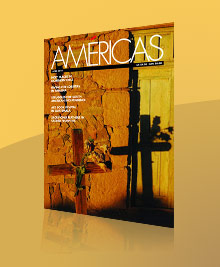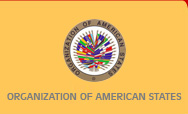
As Haitians struggle to rebuild
their lives after the devastating January 12
earthquake, representatives of the Inter-American
System are forging strategies to aid in the
reconstruction of the hemisphere’s poorest country.
Américas joins in solidarity with
the people of Haiti by asking our readers to give
generously to the Pan-American Development
Foundation (PADF), the OAS response mechanism for
emergencies and natural disasters. In upcoming
issues, we will continue to bring you stories of
Haiti’s challenges and the progress being made
there.
This issue initiates two
significant anniversaries in the hemisphere. One is
the centennial of the House of the Américas, the
Washington headquarters of the OAS and a symbol of
inter-American unity. The other commemoration is
just beginning. Two centuries ago, sixteen Latin
American nations from Mexico to Argentina began
their struggles for independence from Spain. This
issue contains the first installment of history from
that fourteen-year period.
And while the passage of time is
sometimes met with ritual and celebration, at other
times it is noted only with subtle signs, or objects
found under layers of sand in remote deserts. Images
of cemeteries in the Norte Grande of Chile are a
testament to a vivid past now long forgotten.
Not so long ago, children from a
Colombian village went to school everyday by
crossing a deep abyss on a cable device. The
precarious cable is still used to transport farmers
and their products to the town center of Guayabetal.
They persevere, and so do the Ngöbe-Buglé indigenous
people of Panama, who continue the increasingly
risky tradition of diving for lobsters in the ocean
depths.
Two other indigenous groups in
Colombia, the Nasa and the Arhuaco, are being
supported by the OAS Mission of Support for the
Peace Process (MAPP-OAS) as they confront their
region’s cruel history of violent armed groups and
consolidate new forms of resistance.
In Bolivia and Panama,
governments are helping to keep nature and culture
in balance by raising awareness about the use of
wild bird feathers and other such items in costumes
for traditional carnavals.
And speaking of ancestral art
forms, two visionary North American artists are
helping recover the ancient art of fine book-making
among the descendents of the Maya in Guatemala.
There, near the colonial town of Antigua, Kachiquel
artisans are once again becoming “people of the
book.”
Finally, this issue also
recognizes some of our hemisphere’s great writers,
artists, and musicians, with stories on: José
Donoso’s recently released diaries; the
controversial and charismatic Brazilian artist
Tarsila do Amaral; and the cultural messages woven
into the work of pianist and composer Gabriela
Frank.



